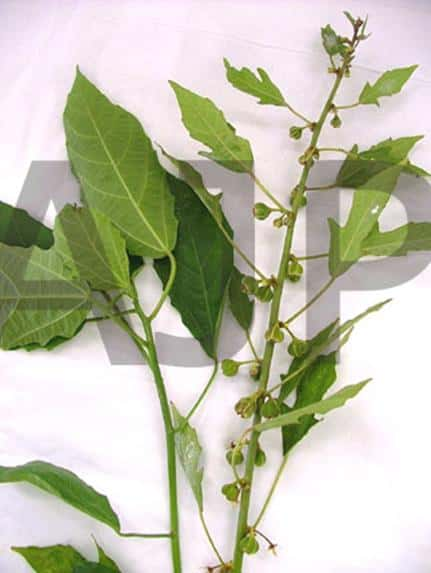
Botanical Name : Baliospermum montanum (Willd.) Muell.-Arg.
Family : Euphorbiaceae
Introduction :
Mainly roots of danti using for virecana.
Names in different Indian languages :
Hindi : Danti
Kannada : Kaduharalu
Malayalam : Nagadanti,danti
Sanskrit : Danti
Tamil : Nakatanti
Telugu : Adaviamudamu, kondaamudamu
Folk : Jangli Jamaalgotaa
Synonyms :
Nikumbha, Udumbarparni, Erandphalaa, Shighraa, Pratyak-shreni, Vishaalya, Erandaphalá, Upacitra Udumbaraparni, Makulaka
Baliospermum axillare Bl.,Baliospermum polyandrum Wt.,Croton polyandrus Roxb
Classification according to Charaka, Susrutha & Vagbhata :
Charaka : Bhedaniya, Mulini dravyas
Susrutha : syãmãdi, Adhobhigahara
Vagbhata : syãmãdi
Varieties & adulterants – (CV – controversy, AD – adulterants) :
1. Laghu danti
2. Brahat danti
3. B. axillare
4. Jatropa curcus [CV]
5. Jatropa montana [CV]
6. Croton tiglium [CV]
7. C.polyandrum
8. J. glandulosa
9. Naga danti – common name used in Kerala
Morphology :
A stout monoecious leafy shrub, 0.9-2 m high.
Leaves— simple, sinuate-toothed lower large, 15-30 cm long, oblong-ovate or rounded or palmately 3-5 lobed; upper small 5-8 oblong, lanceolate; petioles with pair of stipular glands.
Flowers— in axillary racemes, all male or with a few female below.
Fruit- capsule, obovoid, large.
Seeds— oblong, mottled.
Flowers occur in March-April and fruits appear later.
Distribution & Habitat :
Tropical and subtropical Himalayas and in South India also.
Chemical constituents :
Root— baliospermin, montanin
Seeds— axillarenic acid
Properties :
Rasa : Katu
Guna : Guru, Tikshna
Virya : Usna
Vipaka : Katu
Karma : Kapha-vatahara, Recana, Dipana,virechana,Purgative, digestive, anti inflammatory
Indication :
Vãtaja Udara, Arsas, Vrana, Asmari, süla, Krmi, Kustha, Kandü, Pliharoga, Gulma etc.
Constipation, anemia , leucoderma, skin disease
Note— Root is used among the virechana dravyas.
Part used :
Root, leaves, seed oil
Dosage :
Root powder 1-3 g; seed powder 125-250 mg; seed oil 2-5 drops.
External uses :
The paste of roots and seeds is used in oedema and pain. The root paste is applied on painful oedema and haemorrhoids. Seed oil is used for massage in vata disorders.
Internal uses :
Digestive system : Being an appetizer, liver stimulant, cholagogue and laxative, it is used in anorexia, haemorrhoids and helminthiasis.
Circulatory system : It is a blood purifier, raktagami. It reduces oedema by its eliminative action. Useful for elimination of doshas in jaundice.
Respiratory system : Decoction of the leaves is used in dyspnoea.
Urinary system : Useful in calculi.
Skin : As it is diaphoretic. it cures skin disorders by eliminating doshas.
Temperature : Useful in fever with constipation.
Satmikaran : It has an antidote action though vikasi is the property of poison.
Method of collection : Take the root of danti-dravanti which is stiff , thick, blackish red in colour, add long pepper and honey and make a paste. Then cover it with kushas (a particular type of grass) and give pulapak. Then make it dry by keeping it in sunlight or by heating it on a stove. This process reduces the vikasi action of danti-dravanti. Higher dose causes intoxication. Antidote is sweet and unctuous drugs, sugar, water, milk and ghee.
Important Yogas or Formulations :
Dantyarishta. Dantyadi churna, Dantiharitaki, Dranhibhedana lepa
Therapeutic Uses :
(1) Gulma— Danti, Citraka, Snuti ksira, Arka ksira, Guda, Bhallãtaka bija & Kasisa are made into paste and applied locally (V.M.).
(2) Netrãbhiyanda— Fresh juice of Danti is mixed with honey used as Anjana (G.N:)
(3) Udara— Danti should be given with Saindhava and Ajamoda (S.S.Ci. 14).





